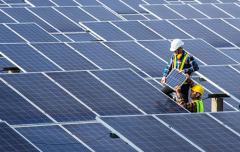Energy efficiency: Are development banks missing a trillion-dollar opportunity?
If we are to successfully stabilize the world’s climate and get to a 1.5ºC world, energy efficiency will play a crucial role. As leaders attend the Asian Development Bank Annual Meetings in Fiji this week, it’s time to zero-in on the trillion-dollar opportunity available by investing in energy efficiency.
Energy efficiency pays for itself. By lowering energy demand, it reduces the need to build costly new power plants and will make it much easier to shift to 100% renewable energy. The World Bank’s private sector arm IFC has identified $23 trillion of climate investment opportunities in emerging markets, many of which are in energy efficiency. In the EU, efficient product regulations will have saved consumers €100 billion annually on their energy bills by 2020.
Last year, E3G analysed climate change practices at several major development banks. On energy efficiency however, the research found despite the huge economic opportunity, not enough information is available on what the various banks are doing.
In regions such as South East Asia, energy demand and emissions are rapidly rising. SEforALL and E3G have been working on a project on shifting finance flows to clean energy and energy efficiency.
Looking at the country strategies of the Asian Development Bank, for instance, in Philippines, energy efficiency was not mentioned within the recent country strategy. The Multilateral Development Banks may be missing a major opportunity for low carbon investment to save money and energy.
Pioneering examples
There are leading examples among development banks. Under the IFC’s EDGE program, a ‘green building’ is defined as one that reduces energy and water use by at least 20%. A target has been set of 20% of new construction to be in green buildings. However, this has only been applied by IFC. Could other banks, including Asian Development Bank adopt a similar approach, and strengthen the efficiency requirement?
In addition, the European Bank for Reconstruction and Development (EBRD) requires energy efficiency screening of all built environment projects. Could this type of policy be applied across the other development banks?
Given development banks are often funding infrastructure with long lifespans and mobilising private sector funding, this could be a way to improve performance of assets and reduce costs for decades to come.
Industrial energy efficiency provides advantages such as increased competitiveness, improved operational efficiencies and productivity, reduced material losses and solid waste, decreased water use, and improved product quality.
EBRD has also had excellent results through the Green Economic Financing Facility which provides credit lines to local banks to finance green investments such as energy efficiency. This has supported more than 130 local financial institutions across 24 countries with almost EUR 4 billion in finance.
In addition, development banks can support technical advice on policies for energy efficiency to governments, for example on product or building efficiency standards which would save citizens money.
Some way to go – not all efficiency is equal
Not all energy efficiency is equal in the context of climate change. Fossil fuel plant efficiency is a type of supply-side efficiency that can end up extending the lifetime of fossil-dependent technology. Some of these fossil efficiency investments are also counted as climate finance.
Demand-side efficiency, which includes more efficient products and equipment, insulation, or upgrading equipment or reducing the climate impact of air conditioning, is ‘cleaner’ since it is does not rely on fossil fuels. Countries, such as China and India, that are beginning to develop National Cooling Plans to include more ambitious Minimum Energy Performance Standards need to be supported.
Development banks should ensure they are not extending the life of technologies that will be ‘stranded’ when the world shifts to renewable energy. For ‘brownfield’ efficiency investments to be counted as ‘climate finance’, old technologies must be replaced before the end of their lifetimes with efficient, new technologies but this still runs the risk that climate finance projects could extend the lifetime of fossil fuel assets.
Clearly, there is still some way to go to integrate energy efficiency into investments by development institutions. The investment opportunity is huge and would support implement of the Paris Agreement. Public banks must seek to adopt best practices - saving both money and the planet.
SEforALL note: This opinion piece first appeared on Medium and can be found here
Photo credit: Niall Kennedy




